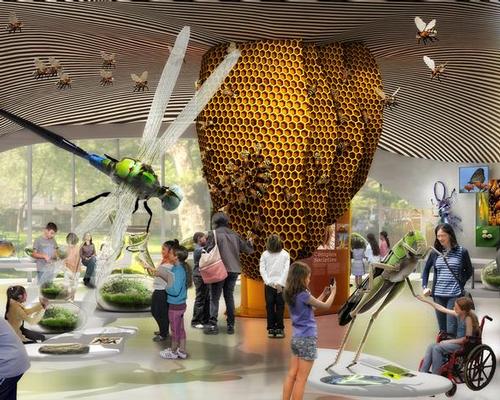13 Jan 2017
American Museum of Natural History reveals details of US$430m expansion
BY Tom Anstey

New York’s American Museum of Natural History has unveiled new details for its US$340m (€319m, £277m) Gilder Center – a massive development intended to expand the institution’s role for scientific research and education.
Adding a 21st century facelift to the 150-year-old museum, the development is being designed by Studio Gang Architects under the leadership of Jeanne Gang, with exhibit design by Ralph Appelbaum Associates and a new design for a portion of the adjacent Theodore Roosevelt Park by landscape architects Reed Hilderbrand.
Among the additions to the cave-like creation, which combines and streamlines the various activities at the museum, the Collections Core will be the main focus, with the 21,000sq ft (2,000sq m) glass-walled exhibit used to investigate and answer fundamental questions, identify new species, and formulate new research questions and directions. The Collections Core will be unique for the museum as both scientists and visiting scholars will be able to carry out research, while observation areas on each of the five levels will allow visitors to, for the first time at the museum, see actual storage spaces and view collections and the current work being conducted.
Another major part of the new expansion will be the 5,000sq ft (465sq m) Insectarium featuring live insects, collections of insect specimens, scientific tools used for conducting research, exhibits, and digital displays that will enable visitors to better understand what insects are, why they are so numerous and diverse, and how directly they relate to other life on Earth today.
Directly above the Insectarium will be the 3,000sq ft (290sq m) Butterfly Vivarium, which will double the space of the existing seasonal Butterfly Conservatory, offering a year-round living exhibit, with the move also returning the Whitney Memorial Hall of Oceanic Birds to full public view.
Berlin-based Tamschick Media+Space and Seville-based BMA Boris Micka Associates will design the immersive Invisible Worlds Theater – a 9,520sq ft (885sq m) venue which will presenting a “compelling and radically new understanding of nature and current science” that visitors will experience through visualisations inside the counterpart to AMNH’s Hayden Planetarium.
In addition to new exhibits, the 21st century revamp of AMNH will include next-generation facilities, including a Family Learning Zone made up of six classrooms, a Middle School Learning Zone serving grades five through eight, a High School Learning Zone and a Teacher Professional Development Zone designed to prepare teachers to use Museum resources in support of science learning in three dedicated and adjacent classrooms in the Museum’s existing complex.
The project has received approval from the New York City Landmarks Preservation Commission following a majority vote by Manhattan Community Board 7 to approve the designs on 5 October.
In terms of financing, US$70.1m (€65.6m, £57m) has been allocated by the City of New York and US$12m (€11.2m, £9.8m) by the State of New York. The museum is still seeking funding for the development – the most significant for the institution since the Hayden Planetarium building was redeveloped in 2000 – with more than half of its US$325m goal reached. The museum’s namesake Richard Gilder – a longtime donor to the museum and stockbroker – has also contributed US$50m (€46.9m, £40.7m) towards the expansion.
Close Window